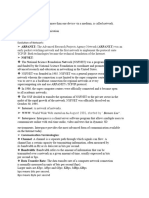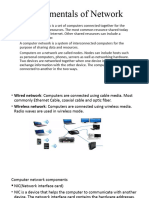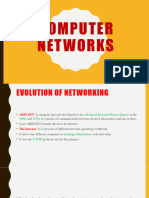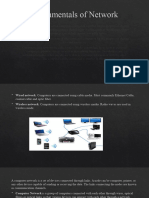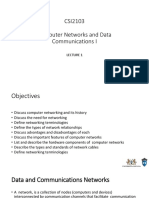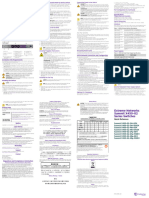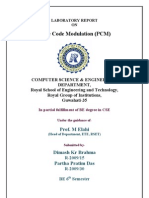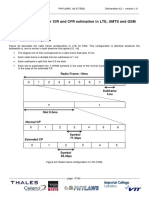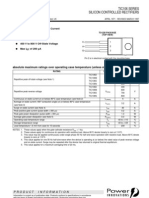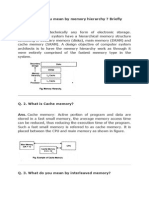A computer network is a set of nodes like computers and networking devices that are connected through
communication for the purpose of communication and sharing resources(hardware/software) among the users.
Benefits of computer network
• Facilitate communication through email / video conferencing / instant messaging or any other mode. • Share
hardware devices like a printer or scanner • Enable file sharing • Share software or operating programs • Share
information
Disadvantages of computer network
Lack of robustness, security issue, cost of network
Evolution of networking
ARPANET (Advanced Research Projects Agency network): In 1969, The US govt. formed an agency named ARPANET to
connect computers at various universities and defense agencies. The main objective of ARPANET was to develop a
network that could continue to function efficiently even in the event of a nuclear attack.
The National Science Foundation Network (NSFNET) was a program of coordinated, evolving projects sponsored by the
National Science Foundation (NSF) from 1985 to 1995 to promote advanced research and education networking in the
United States
Internet (INTERconnection NETwork): The Internet is a worldwide network of computer networks. It is not owned by
anybody. The internet has evolved from ARPANET. The internet is a globally connected network system that utilizes
TCP/IP to transmit information.
Interspace: is a client/server software program that allows multiple users to communicate online with real –time
audio, video and text chat in dynamic 3D environments.
Data Communication Terminologies Communication is the means of sending or receiving information, such as
phone lines or computers. Components of communications sender, receiver, message, communication media and
protocols
Sender : A device or computer that send information/data. Receiver : A device or computer who receives
data/information. Message : An information needs to broadcast. Transmission Medium : It is a physical path with the
help of which information goes from sender to receiver. Protocol: It is a collection of rules which regulates transfer of
information.
Nodes(Workstations) : The term nodes refers to computers that are attached to a network and are seeking to share
resources.
Server : A computer that facilities the sharing of data, software and hardware resources on the network. Network
Interface Unit (NIU) : A Network interface unit is an interpreter that helps in establishing communication between the
server and the client.
IP Address : Every machine on a TCP/IP Network has a unique identifying number called an IP Address. Domain
Name : It is a way to identify and locate the computers connected to the internet. It must be unique.
URL(Uniform Resource Locator) it stands for "Uniform Resource Locator." A URL is the address of a specific webpage or
file on the Internet. For example, the URL of the TechTerms website is "http://techterms.com." for ex -
"http://techterms.com/definition/url" . It has following information- – http:// – the URL prefix, which specifies the
protocol used to access the location – techterms.com – the server name or IP address of the server – /definition/url –
the path to the directory or file
Communication Channel (Transmission media): A communication channel is either a physical transmission medium
such as a wire, or to a logical connection over a multiplexed medium such as a radio channel in telecommunications
and computer networking.
Bandwidth: The amount of data that can be transferred from one point to another.it is a measure of the range of
frequencies a transmitted signal occupies. In digital systems, bandwidth is the data speed in bits per second. In analog
systems, bandwidth is measured in terms of the difference between the highest-frequency signal component and the
lowest frequency signal component. Bandwidth is expressed in Hz, KHz, and MHz.
�Data transfer rate: DTR is the amount of data in digital form that is moved from one place to another in a given time on
a network. Data rates are often measured in megabits (million bits) or megabytes (millionbytes) per second.
Wired Networks - It is also known as Ethernet networks, that is most common type of LAN technology. A wired
network is simply a collection of two or more computers, printers, and other devices linked by Ethernet cables/ any
form of wired media. Ethernet is the fastest wired network protocol, with connection speeds of 10 megabits per second
(Mbps) to 100 Mbps or higher. Computer must have an Ethernet adapter (sometimes called a network interface card,
or NIC) to connect with wire. Most of the network topology uses wired networks.
Wireless Networks – It uses high-frequency radio waves rather than wires to communicate. Wireless allows for devices
to be shared without networking cable which increases mobility but decreases range.
Switching Techniques: It is a way to send a message from sender to receiver. Information may be switched as
it travels through various communication channels. There are three typical switching techniques available for digital
traffic.
• Circuit Switching • Packet Switching • Message Switching
Types of Network
• PAN – PERSONAL AREA NETWORK : PANs are small networks which can be established to set communication
between computer and hand handed devices. Its maximum distance capability is 10 meter. For ex- connection of two
devices by Bluetooth, connection of computer and mobile via USB. PANs are used to transfer files, e-mails etc in
computers, mobiles and tablets etc. • LAN – LOCAL AREA NETWORK : It’s a small network of computers to share
resources. It is in a limited area like residence, school, laboratory, university campus and office building etc. • MAN –
METROPOLITIAN NETWORK : It is a computer network which spreads over a city like area. MAN is basically collection of
small LANs. • WAN – WIDE AREA NETWORK : It is wide telecommunication network which spreads over a very huge
geographical area . It can be through out a country or world.
Network devices
Computer hardware devices which are used to connect computers, printers, or any other electronic device to a
computer network are called network devices.
Some devices are installed on the device, like Internal modem, NIC card or RJ45 connector, whereas some are part of
the network, like router, switch, etc.
NIC – A network interface card (NIC) is a hardware component, typically a circuit board or chip, installed on a
computer so it can connect to a network. Modern NICs provide functionality to computers, such as support
for input/output interrupt, direct-memory access interfaces, data transmission, network traffic engineering and
partitioning.
MAC Addresses are unique 48-bit hardware numbers of a computer that are embedded into a network card
�RJ-45 (Registered Jack – 45) is an eight wired connector that is used to connect computers on a local area
network (LAN), especially Ethernet.
HUB A hub has many ports, and a computer that wants to connect to the network plugs into one of them.
When a data frame arrives at a port, the hub broadcasts it to all other ports, regardless of whether it is destined
for a specific destination(regardless of the MAC addresses).
There are two types of HUB
Passive HUB:- It only forwards the signal on all ports without amplifying the signal.
Active HUB:- it forwards the signal with improvement in the quality of data signal by amplifying it. That why
such hubs need additional power supply.
Based on port type, there are two types of HUB:-
Ethernet HUB :- All ports have RJ-45 connectors.
Combo HUB :- Several different types of connectors such RJ-45, BNC, and AUI available as ports in such
HUB.
SWITCH:- A SWITCH has many ports, and a computer that wants to connect to the network plugs into one
of them. When a data frame arrives at a port, the switch broadcasts it to the specific destination according to
the MAC addresses.
MODEM – Modem is short for Modulator Demodulator. It’s an electronic device used to access the Internet
that modulates carrier waves to encode information to be transmitted and also demodulates incoming carrier
waves to decode the information they carry. Modulation means digital to analog signal conversion and its vice
versa is known as demodulation.
REPEATER – In a network signal travels a long distance in transmission media. Due to resistance of media signal
becomes weak. Repeater is a networking device which regenerates the signal and forwards these signal with more
power.
GATEWAY – A networking device capable to convert protocols so that two different network architecture based
system can communicate with each other. It works as protocol convertor.
Router vs Gateway Gateway regulates traffic between two dissimilar networks, while router regulator traffic
between similar networks. A router is a hardware device that forwards data
packets between computer networks. Routers perform the traffic directing functions on the Internet.
Wi-Fi cards - are small and portable cards that allow your computer to connect to the internet through a
wireless network. WiFi transmission is through the radio waves, these signals are picked up by Wi-Fi receivers
such as computers and cell phones equipped with Wi-Fi cards. The devices need to be within the range of a
Wi-Fi network to receive the signals and produces a wireless internet connection.
Structure of a network- The geometrical arrangement of computer resources, network devices along with
communication channel is known as Network structure or Network topology. Topology can be physical or
logical
Physical Topology-physical layout of nodes and cables in the network. •
Logical topology - the way information flows between different components.
Types of Physical Network Topologies
• Bus Topology
�It is a network configuration where all devices share a common communication line, often a single cable. In
this setup, all computers and devices are connected to the same central cable, forming a linear structure.
Data sent by one device travels in a single direction along the bus, and all connected devices receive the
information.
• Star Topology
Star topology is like your vehicle’s wheel spoke. Each device connected to a central hub or switch known as
‘central device.’ In star set-up, the communication of devices passes through the central hub, which acts as a
mediator, managing and directing data traffic.Unlike bus topology, each device has its own dedicated
connection to the central hub. This design enhances reliability and simplifies troubleshooting, as issues with
one connection do not affect others.
Ring Topology
� In this structure, each device is connected to exactly two other devices, forming a circular or ring-like
structure known as ring network topology. The data travels in one direction through the ring, passing from
one device to the next until it reaches its destination.
Each device in the ring acts as a repeater. They regenerate and forward the data to the next device. Ring
topology is known for its simplicity and uniform data distribution.
• Mesh Topology
In mesh, each device is interconnected with every other device in the network. It seems like devices create
an extensive web of connections. Mesh topology can be categorized into two types:
Full mesh, where every device is directly connected to every other device.
Partial mesh, where only selected devices have direct connections.




